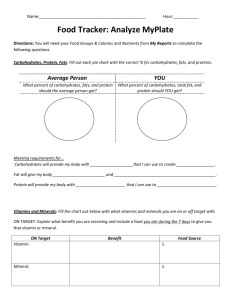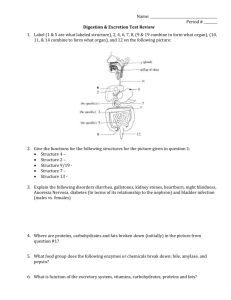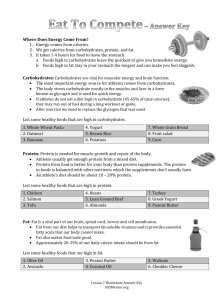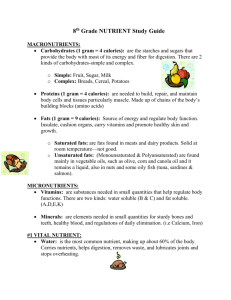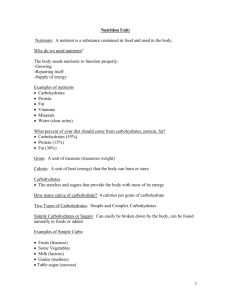08.03.05 Nutrition for Peak Performance
advertisement
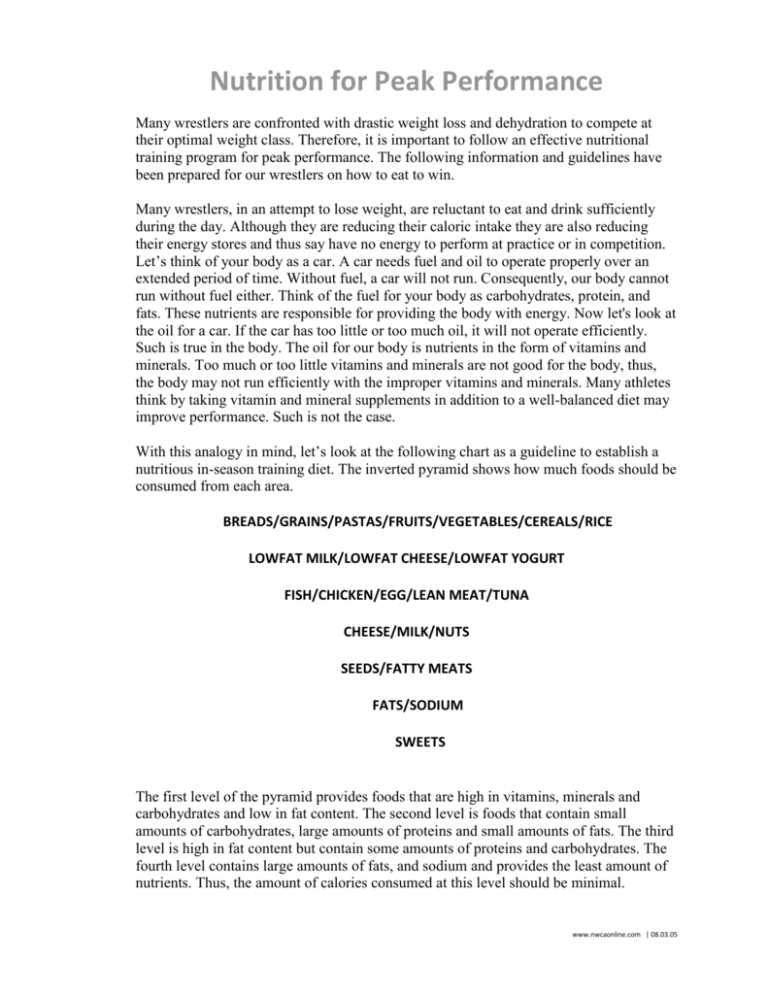
Nutrition for Peak Performance Many wrestlers are confronted with drastic weight loss and dehydration to compete at their optimal weight class. Therefore, it is important to follow an effective nutritional training program for peak performance. The following information and guidelines have been prepared for our wrestlers on how to eat to win. Many wrestlers, in an attempt to lose weight, are reluctant to eat and drink sufficiently during the day. Although they are reducing their caloric intake they are also reducing their energy stores and thus say have no energy to perform at practice or in competition. Let’s think of your body as a car. A car needs fuel and oil to operate properly over an extended period of time. Without fuel, a car will not run. Consequently, our body cannot run without fuel either. Think of the fuel for your body as carbohydrates, protein, and fats. These nutrients are responsible for providing the body with energy. Now let's look at the oil for a car. If the car has too little or too much oil, it will not operate efficiently. Such is true in the body. The oil for our body is nutrients in the form of vitamins and minerals. Too much or too little vitamins and minerals are not good for the body, thus, the body may not run efficiently with the improper vitamins and minerals. Many athletes think by taking vitamin and mineral supplements in addition to a well-balanced diet may improve performance. Such is not the case. With this analogy in mind, let’s look at the following chart as a guideline to establish a nutritious in-season training diet. The inverted pyramid shows how much foods should be consumed from each area. BREADS/GRAINS/PASTAS/FRUITS/VEGETABLES/CEREALS/RICE LOWFAT MILK/LOWFAT CHEESE/LOWFAT YOGURT FISH/CHICKEN/EGG/LEAN MEAT/TUNA CHEESE/MILK/NUTS SEEDS/FATTY MEATS FATS/SODIUM SWEETS The first level of the pyramid provides foods that are high in vitamins, minerals and carbohydrates and low in fat content. The second level is foods that contain small amounts of carbohydrates, large amounts of proteins and small amounts of fats. The third level is high in fat content but contain some amounts of proteins and carbohydrates. The fourth level contains large amounts of fats, and sodium and provides the least amount of nutrients. Thus, the amount of calories consumed at this level should be minimal. www.nwcaonline.com | 08.03.05 In addition to the above pyramid, when establishing a training diet, remember three important concepts: 1. The first essential concept is variety. Your diet should consist of a variety of foods including breads, grains, lean meats, poultry, pasta, fish, milk, fruits and vegetables. 2. The second important concept is individualization. All athletes may have different types of foods they like, thus when selecting a variety of foods to eat, be sure to choose the foods that are appealing to you and that make you feel good about yourself. This will make a nutritional training program much easier to follow. 3. The final concept is moderation. Since it is very difficult to eliminate fatty foods with low carbohydrate and protein content from our diet completely, it’s essential that we eat these foods in moderation (i.e. 2 to 3 times a week.) Also, be aware of the way the foods in the pyramid are prepared. Foods high in carbohydrates and proteins may also be high in fats if they are fried. Broiled and steamed foods will help eliminate a lot of fats and cholesterol from your diet. Now that we have a model of the types of foods and the amount of each to consume each day, let’s take a look at calories and our ratio intakes. Calories are a form of energy that are necessary to maintain a balance of lean body weight and fat. Therefore, do not drastically reduce your daily caloric intake while training in an effort to decrease body weight. Calorie reduction is much more effective if you slightly decrease the amount of daily caloric intake and increase your daily activity level. The following two tips may serve as a guide: 1. Eat to get the right amount of calories. These calories should come from carbohydrates, proteins and fats. Since fats contain twice as many calories (252/g) as carbohydrates (112/g) and proteins (112/g). Your daily diet should consist of the following: 55-70% of your total calories taken in each day should consist of carbohydrates. 25-35% of your total calories taken in each day should consist of fats. 10-15% of your total calories taken in each day should come from proteins. Once you have established the amount of calories that are sufficient for you to maintain a natural body weight at your daily training activity level, you may begin to lose body fat. Simply reduce your caloric intake by 300-600 calories a day and implement an additional daily activity into your regular activity. This will reduce your weekly caloric intake to 2,100-4,200 per week. Since 3,500 calories equals about 1 pound of fat, you can expect to lose about 1-1.5 pounds per week. It is important to note that when reducing your daily caloric intake you should not eliminate all the calories from one specific category (i.e. carbohydrates, proteins, fats.) You must reduce the caloric intake and maintain the ratio intakes. For example, your daily caloric intake to maintain a consistent body weight for your daily training activity level is 3,000 calories a day. Now, reduce your daily caloric intake to 2,500 calories a day. This will mean your daily amount of calories should consist of: www.nwcaonline.com | 08.03.05 1375 to 1750 calories from carbohydrates (2500 x .55 = 1375 or 2500 x .70 = 1750) 626 to 875 calories from fats (2600 x .26 = 626 or 2500 x .35 = 875) 300 to 375 calories from proteins (2600 x .12 = 300 or 2500 x .15 = 375) With this in mind, maintain your daily training activity level and add an activity that will burn an additional 200 calories a day, such as biking, drilling or a 15minute jog. From this example, you can expect to lose about 4,900 calories a week which is equivalent to 1.4 pounds of body fat per week. Since carbohydrates provide most of our energy, they are an important part of our daily training diet. These carbohydrates are important for producing glycogen in the body. Glycogen is then broken down and used as a fuel for our energy source. However, our body is limited in the amount of carbohydrates that it can store in the body and liver. Therefore, it is very important to replenish your carbohydrate stores (55-70% of your total caloric intake) frequently if you are following an intense training. Proteins are also vital in the training diet but should constitute only 12-15% of your daily calories. Many athletes think you can increase muscle by increasing your daily protein intake. This is not the case. Increased strength and muscle mass comes from increased activity and work load, along with providing your body with all the essential nutrients and vitamins it needs. An excess amount of proteins puts extra stress on the body. Since fats contain twice as many calories as proteins and carbohydrates you should limit your daily intake of fats to 26-36% of your total calories. Carbohydrates are the primary energy source when you’re exercising hard and are the main fuel for your body. Your diet should include carbohydrates that are high in carbohydrates and low in fats. These foods include: Bagels Pancakes Crackers Rice Pasta starches Dried beans Vegetables and fruits Since some carbohydrates contain more fats than others. It is important to identify which are high-fat carbohydrates and which are low-fat carbohydrates. For example, sugar is high in carbohydrates, but also contains large amounts of fat. Proteins are essential for repairing and building muscles, red blood cells, hair and other tissues. They are digested into amino acids which are rebuilt into the protein in muscle and other tissues. These proteins are important in our diet because of the rigorous physical training involved in the sport of wrestling. Different types of proteins include: Fish Chicken Tuna Turkey www.nwcaonline.com | 08.03.05 Beans Lean Meats Eggs Fats are a source of stored energy (calories) that we burn primarily during low level activity, such as sleeping or reading. Animal fats such as butter, lard and fats in meats tend to be saturated and cause heart disease and some forms of cancer. Vegetable fats such as olive oil, corn oil, etc. tend to be unsaturated fats and are less harmful. Other foods that are high in fat content are potato chips, fried foods, fast foods and sweets. 2. The second tip to a proper training diet for peak performance is fluids. Many wrestlers tend to make weight through dehydration, but they do so too early or without first reducing body fat. By following the guidelines in the first tip, you can reduce the percentage of body fat you possess and after a 6 to 8 week period you can lose between 9 and 12 pounds of body fat. During this time fluids should be maintained at a constant level so you can practice and compete daily. By dehydrating your body, you lose some minerals (electrolytes) such as potassium, sodium, chloride, and magnesium. These electrolytes help your body function normally. Therefore, it is important to avoid dehydration while training. After each work out and competition it is important to replenish your electrolytes. The following is a list of items that are high in the essential electrolytes: Bananas Gatorade and other sports drinks Orange Juice Potatoes Yogurt All the above contain sufficient amounts of potassium while spaghetti, soups and crackers contain enough sodium to help restore the body’s sodium content. Please note that salt tablets are not recommended and can be harmful. To see if dehydration is occurring, check the color of your urine. If the color is dark yellow, it is concentrated with metabolic wastes and you need to increase your fluid level. Since the body can absorb only about 1 quart (2 pounds) of fluid an hour, you should drink 2-3 cup every 15-30 minutes. Any more than this will lie in your stomach and you may feel bloated. Continue to hydrate your body continuously during your daily workouts and as needed. PREPARING FOR COMPETITION The day before and the day of competition are your most important days to replenish your carbohydrate stores. However, be sure to avoid high fiber foods such as corn, fibers, cereals, beans, prunes and foods that are hard to digest by the body or foods that may cause indigestion. Choose foods that are high in carbohydrates and make you feel like a winner approximately 4-6 hours prior to competition. Also, eliminate high sugar foods the day of a match since this may increase blood sugar levels. During day-long tournaments, eat small amount of fruits and juices or yogurt which are quickly digested and may replenish electrolytes and carbohydrate stores that you lost while making weight. www.nwcaonline.com | 08.03.05 Although most wrestlers tend to make weight the day of weigh-ins through fluid loss, it is not recommend to dehydrate your body for more than 2 hours prior to weigh-ins nor is it advisable to lose more than 4-8 pounds or (4% of your total body weight) of fluid weight during that 2-hour work out period. The amount of fluid weight lost will depend on the size of the individual and the amount of body fat that he has lost. Once the workout is complete and the weight has been made, be sure to hydrate your body. Remember your body can absorb only about 2 quarts of water an hour. Therefore, if you lost 4 pounds during your workout and only have 1 hour until competition, your body will not be hydrated completely and you may not be able to achieve a peak performance. The day after weigh-ins or competitions, replenish electrolytes, fluids, vitamins and minerals, and glycogen stores by eating a high carbohydrate meal along with two other well-balanced meals from the food pyramid. Nutrition is only one of several key factors to achieve a peak performance. Hard work, desire, dedication, preparation and perseverance are all other important factors. But remember, no matter how hard you train, or how badly you want to be a champion, your body can only perform as well as the fuel and oil you put in it. Go to the following website for more information on nutrition and performance: http://www.nwcaonline.com/sportscience.cfm www.nwcaonline.com | 08.03.05


